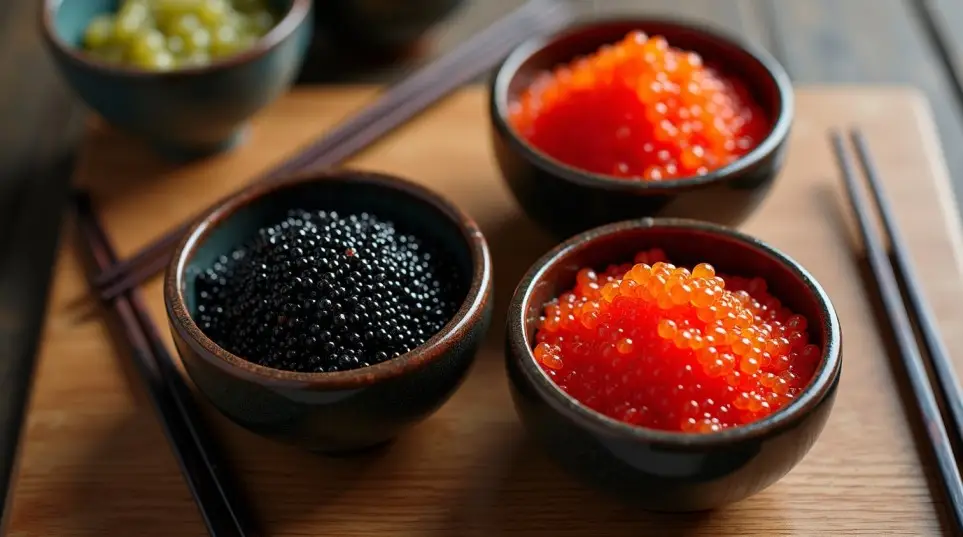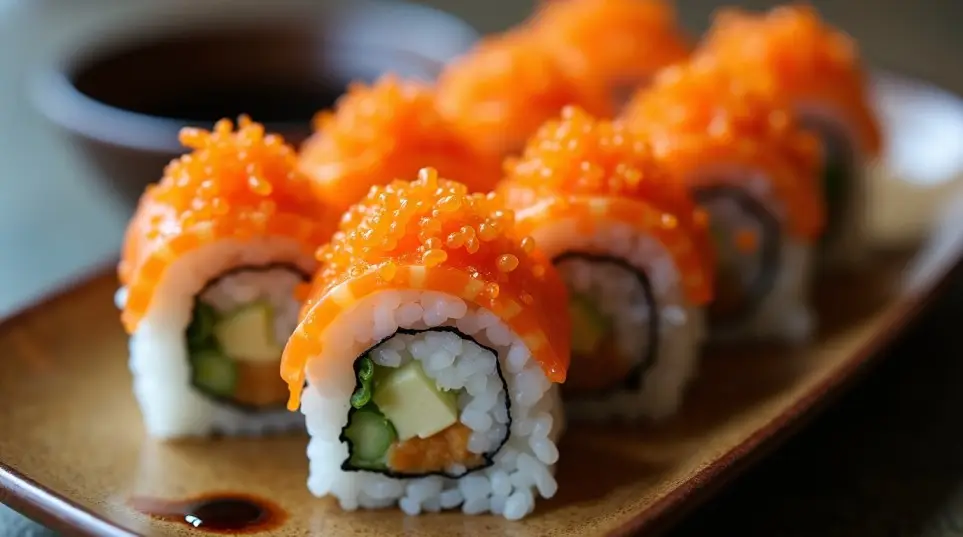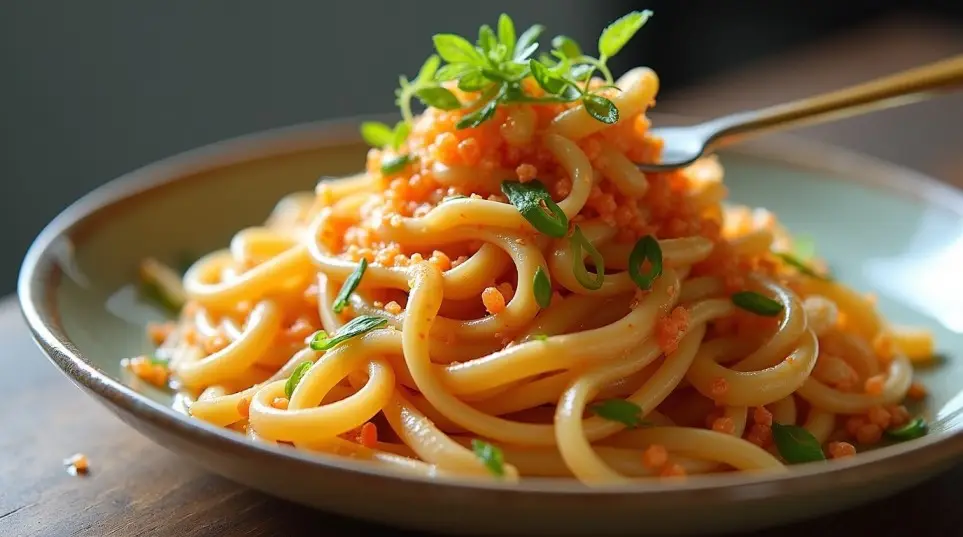If you love Japanese cuisine, you’ve probably come across tobiko—those tiny, crunchy, and colorful fish eggs that add a delightful burst of flavor to sushi and other dishes. But what exactly is tobiko, and why is it so popular? This guide will take you through everything you need to know about tobiko, from its types and nutritional value to recipes and buying tips.
What is Tobiko?
Meaning and Origin
Tobiko refers to the roe (eggs) of flying fish, commonly used in Japanese cuisine, especially in sushi. These tiny, orange-colored eggs are known for their crunchy texture, mild smoky-salty flavor, and vibrant appearance.
Difference Between Tobiko, Masago, and Ikura
| Type | Source | Size | Color | Texture | Flavor |
|---|---|---|---|---|---|
| Tobiko | Flying fish | Small | Orange (varies) | Crunchy | Mild, slightly sweet |
| Masago | Capelin fish | Very small | Pale yellow (dyed orange) | Less crunchy | Milder, less flavorful |
| Ikura | Salmon | Large | Bright red/orange | Soft, juicy | Rich, briny |
Tobiko is often mistaken for masago, which is cheaper but has a softer texture and less crunch. Meanwhile, ikura (salmon roe) is much larger and has a juicier pop when eaten.
How Do They Make Tobiko?
The process of obtaining tobiko involves several steps:
- Harvesting: Fishermen collect the roe from wild flying fish.
- Cleaning: The eggs are carefully cleaned to remove impurities.
- Curing: Tobiko is often cured in salt or soy sauce to enhance flavor and shelf life.
- Coloring: While natural tobiko is orange, it is sometimes dyed in different colors:
Tobiko is then packaged and distributed to restaurants and stores worldwide.
Types of Tobiko

Black Tobiko
Black tobiko is made using squid ink, which gives it a dark, jet-black appearance and a slightly richer, ocean-like taste.
Red Tobiko
Red tobiko is often colored with spicy ingredients like chili powder, giving it a hint of heat. This type is popular in spicy sushi rolls.
Tobiko Caviar
Some people refer to tobiko as “tobiko caviar”, but it’s technically different from traditional sturgeon caviar. While tobiko is less expensive, it still provides a delightful burst of umami flavor.
Tobiko Eggs
Since tobiko refers to fish roe (eggs) from flying fish, it is sometimes called tobiko eggs to distinguish it from other types of roe.
Where to Buy Tobiko?
What Aisle is Tobiko In?
If you’re looking for tobiko in a grocery store, check these sections:
- Frozen seafood section (most common)
- Sushi ingredients aisle
- Asian grocery stores
Best Places to Buy Tobiko
- Local Asian supermarkets (They often have fresh and frozen options)
- Online seafood markets (Websites like Amazon and Marukai sell tobiko)
- Japanese restaurants (Some sell tobiko to customers)
Tobiko Nutritional Information
| Nutrient | Per 1 Tablespoon (15g) |
| Calories | 20-25 kcal |
| Protein | 3-4g |
| Fat | 0.5-1g |
| Omega-3 | High |
| Sodium | Moderate |
| Vitamins | B12, D, E |
Health Benefits of Tobiko
- Rich in Omega-3 (Good for heart and brain health)
- High in Protein (Great for muscle building)
- Low in Calories (Good for weight management)
How to Eat Tobiko?
Popular Dishes Featuring Tobiko
- Tobiko Sushi Rolls – A common topping for sushi rolls.
- Tobiko Gunkan Maki – Small seaweed-wrapped sushi filled with tobiko.
- Tobiko Sashimi – Served on its own as a delicacy.
- Tobiko Pasta – A fusion dish mixing tobiko with creamy pasta.
Tobiko Recipes
1. Simple Tobiko Sushi Roll Recipe

Ingredients:
- 1 cup sushi rice
- 1 sheet nori (seaweed)
- 2 tbsp tobiko
- ½ cucumber, sliced thin
- ¼ avocado, sliced thin
- ½ cup imitation crab, shredded
Instructions:
- Spread sushi rice on a nori sheet.
- Add cucumber, avocado, and crab.
- Roll tightly using a sushi mat.
- Cut into pieces and top with tobiko.
- Serve with soy sauce and wasabi.
2. Tobiko Pasta Recipe

Ingredients:
- 200g spaghetti
- 2 tbsp butter
- 2 tbsp tobiko
- 1 tbsp soy sauce
- 1 tbsp heavy cream
- ½ tbsp lemon juice
Instructions:
- Cook pasta and drain.
- In a pan, melt butter and mix with soy sauce and cream.
- Toss pasta in the sauce and add tobiko.
- Garnish with lemon juice and serve hot.
Frequently Asked Questions
Is Tobiko Raw or Cooked?
Tobiko is cured but not cooked, making it technically raw.
Can You Eat Tobiko If You Are Pregnant?
Since tobiko is raw, it’s best to consult a doctor before consuming it during pregnancy.
How Long Does Tobiko Last?
- Refrigerated: 3-5 days
- Frozen: Up to 6 months
Conclusion
Tobiko is a fantastic ingredient that adds a unique crunch and flavor to sushi and other dishes. Whether you’re a sushi lover or just exploring new foods, tobiko is definitely worth trying! From its rich nutritional profile to its versatile uses in cooking, tobiko is a true delicacy that can elevate any meal.
Explore More:
Enjoy your tobiko adventure!









